#European middlemen
Text
vanilla production facts
it is an orchid
the flower blooms one day per year and must be manually pollinated. pollination causes the base of the flower to swell almost immediately, from there it takes weeks to develop into a seed pod
vanilla costs about $300/lb. this being the pulp of the fruit itself, the extract we are familiar with is dilute. second only to saffron for expense. the price also tends to fluctuate greatly depending on the abundance of any given year's crops
there are three strains of cultivated vanilla. cultivation dates as far back as the totonac people in the 12th century, who live in present day veracruz, on the eastern coast of mexico. the olmecs may have also used wild vanilla in cooking thousands of years earlier
vanilla was cultivated in european botanical gardens but not really used much for 300 years after the colombian invasion of mesoamerica until finally some idiot realized the melipona bee doesn't live there, which may not have even been the correct type of bee (possibly euglossine)
five years later (1841) a 12-year-old slave named edmond albius on the island of reunion figured out how to manually pollinate the flowers, which is an extremely delicate and difficult process. some french botanist claimed to have invented this process, and people believed him for over a century
the aroma doesn't develop until after the seed pod is harvested and processed. it must be sorted, graded, blanched, then alternately sweated and dried for 15-30 days. the blanching halts fermentation, which makes one wonder, what is a fermented vanilla seed pod like?
synthetic vanillin is derived from eugenol, from clove oil, and lignin, from any number of sources. the vast majority of synthetic vanilla is made from wood creosotes which occur as a product of lignin pyrolysis (fire). its major source is, like anything, the petrochemical industry, which requires heat to fractionally distill oil into several byproducts (kerosene, naphtha, gasoline, etc). which is to say, 85% of synthetic vanilla is made from the wood smoke of the oil industry. you might be inclined to ask "doesn't this pollute" which, if you recapture the smoke to sell its particulate creosotes to synthetic vanilla producers, no, i guess not really, or "why don't they use oil to heat the oil" because it is more profitable to sell the oil and burn wood to make it, obviously
it is difficult to tell the difference between natural and synthetic vanilla in baked goods, because the baking process burns off the distinctive notes, most of which differ by growing region (tahitian vanilla is floral, indonesian vanilla is smoky, mexican vanilla is woody or spicy, bourbon vanilla from reunion has an alcoholic richness)
price markup occurs not at the point of farming, but after the point of curing. there is no set price for green vanilla beans, but there is a set price for dried vanilla beans, after they have passed through several middlemen from farmer to broker to curing. after this point, they are marked up several more times before finally making it to grocery store shelves in the form of bottled extract
in 2017 a cyclone destroyed maybe 30-80% of madagascan vanilla crops, where possibly as much as 60-80% of the global supply of vanilla is grown. in the 5 years since then, the price has not recovered, but boy howdy, have the labels gotten more fancy in specifying when it's from madagascar, haven't they?
70% of madagascar lives below the poverty line, despite the island producing the majority of the world's supply of the second most expensive spice
by volume, the number of vanilla beans imported to the united states every year is nearly two for every single member of the population (~640m, for a ~330m population)
anyway stop pouring a whole bottle of it into a cup for a joke what the fuck is wrong with you people i hope to god that ibuprofen potion post was staged with some vaguely brown liquid. also the word vanilla etymologically derives from the latin vagina meaning sheath ok bye
400 notes
·
View notes
Photo
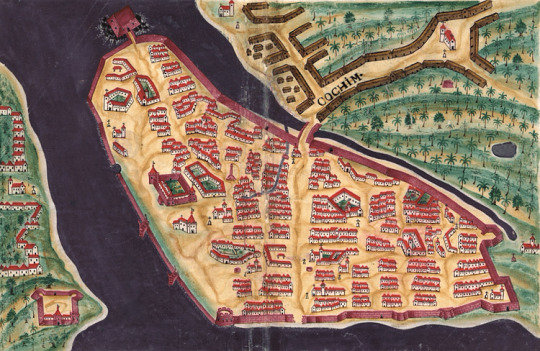
Portuguese Cochin
Cochin, located on the southwest coast of India, was a Portuguese colony from 1503 to 1663. Known to the Portuguese as Cochim, it was one of several important cities on India’s Malabar Coast and a great trade centre for spices like pepper. Cochin was the administrative capital of Portuguese India until it was replaced by Goa in 1530.
A fort was built at Cochin in 1503, the first in Portuguese India, as the Europeans used the city as their first headquarters in the East. The great explorer Vasco da Gama (c. 1469-1524) spent his last days in the city, and it remained a lucrative hub of the spice trade into the 17th century. The city was taken over by the Dutch in 1663, then the English in 1814, and finally gained independence with the rest of India in 1947. Today, the city is known as Kochi and is the most prosperous port in the Kerala region of India.
Vasco da Gama
In the 15th century, the Portuguese colonization of Madeira in the North Atlantic from 1420 was the first in a series of colonial stepping stones that eventually led to India. The treacherous Cape Bojador in West Africa was negotiated in 1434, the Azores were colonised from 1439, Cape Verde from 1462, and São Tomé and Principe from 1486. In 1488 Bartolomeu Dias sailed down the coast of West Africa and made the first voyage around the Cape of Good Hope, the southern tip of the African continent (now South Africa).
The famed Portuguese explorer Vasco da Gama followed in Dias’ wake and pioneered a maritime route from Portugal to India when in 1497-9, he sailed around the Cape of Good Hope, went up the coast of East Africa, and crossed the Indian Ocean to arrive at Calicut (now Kozhikode) on the south-west coast of India. His voyage, supported by King Manuel I of Portugal (r. 1495-1521), was intended to find a legendary Christian kingdom in the East and to give Portugal direct access to the Eastern spice trade and cut out the Arab middlemen traders. The first aim ended up being an illusion but the second was indeed achieved. For the first time, Europe could access by sea a trade which had been going on for centuries but which channelled luxury goods through the Red Sea and the Persian Gulf to be then taken by camel caravan to the Mediterranean. Such goods as pepper, ginger, cloves, and cinnamon were immensely popular in Europe and expensive.
Vasco da Gama, through a mix of inexperience, lack of trade goods, and Indian confidence in the status quo, failed to establish friendly trading relations with Calicut. A second Portuguese expedition, this time with 13 ships and 1500 men and commanded by Pedro Álvares Cabral, set off to repeat da Gama’s feat in March 1500 and was given the brief of muscling-in on Muslim trade by sinking any Arab ships they came across. Vasco da Gama sailed for a second time to India in 1502-3, this time with 15 ships. A result of this voyage was more trouble with the ruler of Calicut, but a trade treaty was agreed with Cochin further down the coast.
Continue reading...
25 notes
·
View notes
Text
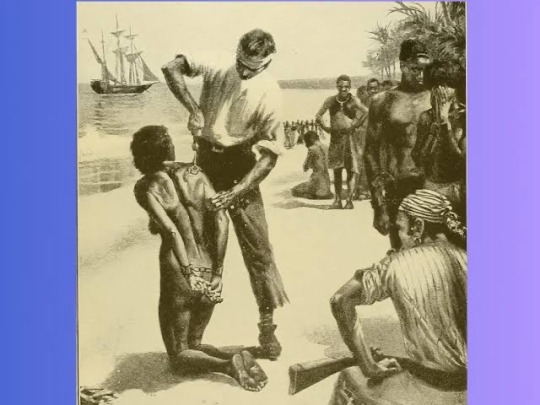

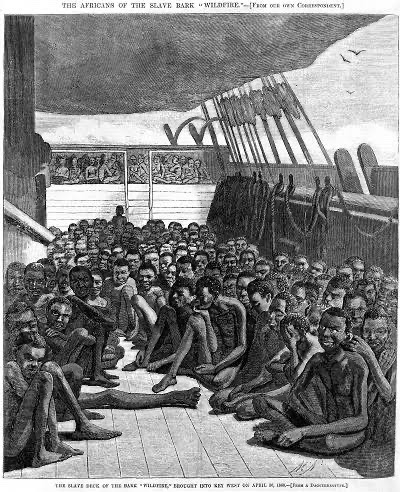
The Harsh Reality of Historical Slave Trade: Africans' Involvement in Selling Their Own
This is a message for my black brothers and sisters
Because of our greed and hatred for our race
We sold ourselves to slavery
The transatlantic slave trade remains one of the darkest chapters in human history, leaving a lasting legacy of suffering, oppression, and discrimination. It is a topic that must be approached with sensitivity and nuance, recognizing the profound impact it had on African communities and the deep scars it has left on the collective conscience of humanity. One aspect that often sparks debate and discomfort is the historical involvement of some Africans in selling their own people to European slave traders. This article aims to shed light on this complex aspect of history while emphasizing the importance of understanding the broader context in which these events occurred.
The Origins of the Transatlantic Slave Trade
The transatlantic slave trade emerged in the 15th century as European powers explored new trade routes and sought to exploit the labor needed to establish and maintain their colonies in the New World. European traders, primarily from Portugal, Spain, England, France, and the Netherlands, sought to acquire laborers from Africa to work on plantations, mines, and other industries in the Americas.
The Role of African Middlemen
It is essential to understand that not all Africans participated in the slave trade, and it is inaccurate to generalize that "blacks sold blacks to the whites." Rather, some African tribes and kingdoms engaged in the business of capturing and selling prisoners of war from rival tribes, criminals, and those deemed outsiders or unwanted in their communities. These captives were then traded to European slave traders for a variety of goods, including textiles, weapons, and other commodities.
It is crucial to acknowledge that the African continent is diverse, comprising numerous ethnic groups, cultures, and societies with varying practices and histories. While some African societies did engage in capturing and trading slaves, others actively resisted the slave trade, viewing it as a deeply harmful and inhumane practice.
Factors Influencing African Participation
Several factors influenced African participation in the slave trade. These include economic incentives, inter-tribal conflicts, and pressure from European powers. The slave trade disrupted existing power dynamics and social structures in Africa, leading to increased conflict and instability in some regions.
Economic motivations were undoubtedly a significant driver. The exchange of slaves for valuable goods provided some African tribes with access to resources they could use to strengthen their position or defend themselves against rival groups. Additionally, some African leaders believed that by trading prisoners of war to European traders, they could avoid becoming victims of the slave trade themselves.
Consequences and Long-Term Impact
The transatlantic slave trade had devastating consequences for African societies. Apart from the immediate loss of human lives and the breakdown of communities caused by forced displacement, the slave trade perpetuated a cycle of violence and disruption that reverberated throughout the continent.
Furthermore, the trade in human beings perpetuated harmful racial stereotypes and discriminatory practices that continue to affect people of African descent to this day. It is essential to recognize the historical roots of racism and the systemic inequalities that have persisted over centuries as a result of the slave trade and colonialism.
Conclusion
The historical involvement of some Africans in the transatlantic slave trade is a deeply troubling and complex aspect of human history. However, it is crucial to avoid oversimplification and instead seek a nuanced understanding of the broader historical context in which these events occurred.
Acknowledging this painful part of history allows us to confront the legacy of slavery and its impact on contemporary society. By understanding the full scope of the transatlantic slave trade, we can work towards building a more just and equitable future, one that respects the dignity and humanity of all individuals, regardless of their race or ethnicity.
#life#animals#culture#aesthetic#black history#history#blm blacklivesmatter#anime and manga#architecture
97 notes
·
View notes
Text
Brazil’s Lula Intensifies Diplomatic Push for Peace in Ukraine

Brazil President Luiz Inácio Lula da Silva is intensifying a campaign to mediate an end to Russia’s war in Ukraine as he seeks to reinsert Brazil in the global political stage.
Russian Deputy Foreign Minister Mikhail Galuzin was quoted by Russia’s Tass news agency Thursday as saying Moscow is studying Lula’s proposal to end the conflict as it continues to assess the situation in Ukraine.
The idea being floated by the Brazilian president is to create of a group of countries, possibly including India, China and Indonesia, to mediate peace talks between the nations as war fatigue starts to grip parts of the world.
Brazil is hardly the only country pushing peace proposals as the conflict approaches its first anniversary on Friday. China, Turkey and numerous others have also sought to mediate negotiations in recent weeks and months.
Lula’s efforts to position Brazil and himself as pragmatic middlemen in the conflict, meanwhile, may still be hurt by comments he made last year, when he told Time Magazine that Ukrainian President Volodymyr Zelenskiy, the United States and the European Union all shared blame for the Russian invasion. A top Ukrainian official slammed the comments as a “Russian attempt to distort the truth” in response.
Continue reading.
#brazil#politics#ukraine#russia#brazilian politics#ukraine crisis#luiz inacio lula da silva#foreign policy#international politics#mod nise da silveira#image description in alt
145 notes
·
View notes
Text
Housemate: "Hey Natalie how's it going?"
Me, has not slept: "So I decided they have tobacco in this fantasy world but northwestern Seshrak is mainly European in character so obviously they'll need to get it from somewhere which opens up some really great new vistas of storytelling but I don't wanna call it tobacco because that's an Arawak word and contact between the hemispheres would occur overland via the poles rather than by sea due to this setting's geography so instead of colonization and a Columbian exchange we've instead got various Fantasy Siberian and Fantasy Alaskan groups acting as middlemen so basically to make a long story short my problem is I forgot the Yupik word for tobacco."
324 notes
·
View notes
Photo

Cloud Man, Assinaboine, 1898, FA Rinehart.
Cloud Man (Assiniboine)" Photo by FA Rinehart, 1898. The Assiniboine were close allies & trading partners of the Cree, engaging in wars together against the Atsina (Gros Ventre). Together they later fought the Blackfoot. A Great Plains people, they generally went no further north than the North Saskatchewan River.They purchased a great deal of European trade goods from the Hudson's Bay Company through Cree middlemen.
104 notes
·
View notes
Text
By: Keith Woods
Published: Jul 2, 2023
A look at slavery outside of the West
It has become popular to blame White people for slavery, to the point that many actually believe slavery was invented by or exclusively practiced by Europeans.
But the history of slavery outside the West is far more brutal.

The Arab slave trade emerged in the 7th century, 10 centuries before the Atlantic slave trade
Arabs sold Africans to the Middle East for a variety of jobs such as domestic work or harem guards - castrating male slaves was common, causing over half of males to bleed to death

The Arab slave trade was particularly brutal: it's estimated that 3/4 captured slaves died before they reached the market for sale
Historians estimate that between 10 and 18 million people were enslaved by Arab slave traders, including women and children taken as concubines.
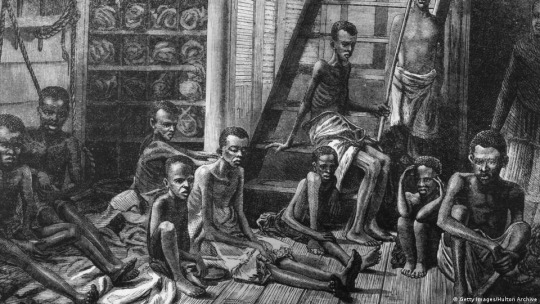
Arabs did not create the slave trade out of nothing, in fact, enslaving conquered tribes was already common practice in Central Africa when they arrived.
The West African Songhai Empire relied heavily on captured slaves in all levels of society, even as soldiers.

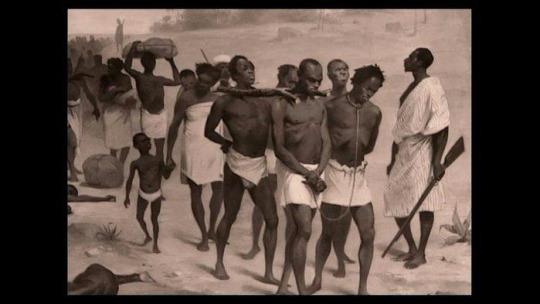
Africans themselves also played a large role in facilitating the trans-Atlantic slave trade.
African tribes conducted raids on rival groups to provide slaves for sale. African middlemen facilitated trade between European traders and African suppliers.



The Arabs also had a slave trade in Europe. Estimates are that up to 1.25 million Europeans were enslaved by Barbary pirates, who would raid villages in coastal countries like Italy, France, England and Ireland, bringing them to North Africa for sale.

In some cases entire villages would be captured, such as the Irish coastal village of Baltimore, entirely raided in 1631.
These slaves faced a brutal future, engaging in hard labour or sexual servitude, and spending nights hot and overcrowded prisons called bagnios.



Many slaves captured by Barbary pirates were sold eastwards into the Ottoman Empire. Slavery was central to the Ottoman Empire, most towns had dedicated slavery markets called Yesirs.
Slaves came from Africa, the Caucasus, the Balkans and Eastern & Southern Europe.

Sexual slavery was a big part of Ottoman society. Slavic women were popular slaves, and Köçeks became a popular source of entertainment in the 19th century:
These were young boys, usually from European backgrounds, who were circumcised, cross-dressed and trained as dancers.


Hereditrary slavery is recorded in China dating back to the Xia Dynasty in 2100 BC. Africans purchased on the Silk Road were used as a sign of wealth.
After Chinese law began to treat women as property around 1000AD it was common to sell daughters and sisters into slavery.
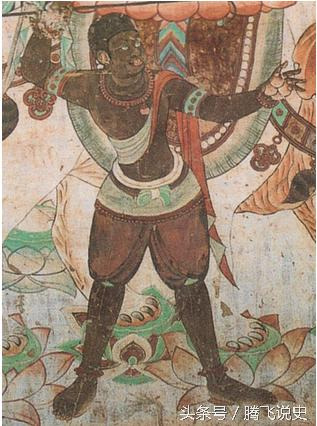

The Mongols enslaves tens of thousands of Chinese as punishment for resistance.
In the post-Mongol Ming Dynasty, thousands of slaves were employed to do bureaucratic jobs for the government, and rich families also employed thousands of slaves to perform menial labour.

Slavery was common in American civilizations like the Aztec and Maya
Among the Aztecs, slavery was a punishment for a variety of crimes or even failure to pay taxes. Husbands and wives sold each other in times of economic hardship. Slaves were identified by wooden collars.
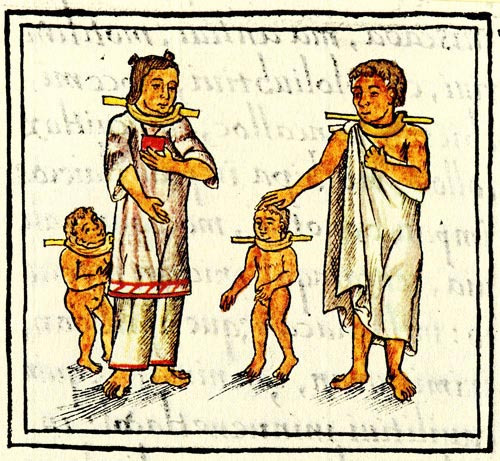
Slavery was also common practice in the civilizations of South-East Asia.
The Khmer Empire had a massive slave class that did much of the work building monuments like Angkor Wat. Historians estimate 25-35% of the population of Thailand/Burma were slaves in the 17th century.
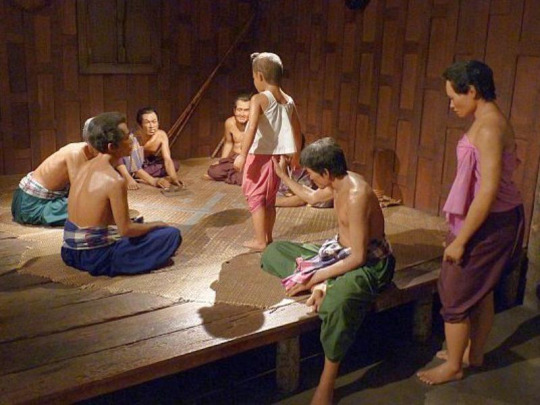

Slavery also existed among Native American tribes. Slavery was common practice among Northwest tribes like the Tlingit, for whom one third of their population during the mid-1800s were slaves.
Various tribes practiced debt-slavery and enslaved captives of other tribes.
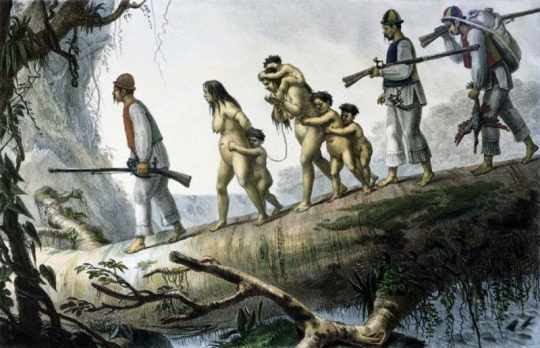

The only difference between these cases of slavery and that practiced by Europeans is that Europeans abolished slavery on humanitarian grounds, and spread this across the globe.
The intense focus on the White role in slavery is a product of widespread Anti-White animus.

==
American exceptionalism comes in two varieties: "we're exceptionally virtuous," and "we're exceptionally evil."
Both rely on lying about or being ignorant of history.
https://www.nationsreportcard.gov/dashboards/schools_dashboard.aspx

And that's just American history. Can you imagine world history?
#Keith Woods#slavery#history#history of slavery#exceptionalism#American exceptionalism#inverted exceptionalism#religion is a mental illness
26 notes
·
View notes
Note
Florida doesn't exist in the untamed universe. The native Americans still have the whole continent back then. Florida is irrelevant. All I'm saying is everyone in cql, mdzs, etc, is a petty little shithead, cuteness notwithstanding
The Florida reference wasn't about the peninsula currently known as Florida, so for clarification's sake: the current governor of Florida is notorious in US domestic politics by passing deeply harmful legislation targeting his state's LGBTQ+ communities, the T in particular. The comparison there was that, while resorting to slurs or hate speech in a moment of anger at a queer person is still homophobic, it's not on the same level as actively wishing harm on the community at large. Why did I use this example? Because I am from the US and invoking another country's politics for my Extreme Homophobia Example would be presumptuous at best.
(Unrelated: man, I would LOVE to know what is going on in the Americas in the CQL universe, because the existence of potatoes and peanuts means Fantasy China has established trade relations with the Fantasy Americas centuries earlier than they did in real life, and with no Fantasy European middlemen to boot. THE IMPLICATIONS FOR FANTASY WORLD HISTORY ARE VAST.)
But to return to the original point: Yes, I know that everyone in MDZS/CQL sucks to some degree. It would be a boring story if they didn't! That's what I was getting at in my snarky little response there. My favorite character--who is so obviously my favorite character that you can tell just by looking at my username and avatar combo--is THEE endgame villain of the story. He kinda sucks! He is my precious son whom I cherish, but I get why so many people don't care for him. Mind, there are certain ways that people express their dislike that make me :/, but as long as they're not deliberately baiting the character tags or clowning on my posts, it's whatever.
So like... I get that he sucks. There are all kinds of reasons someone might personally find him indefensible and not worth analyzing. But I find him interesting and sympathetic, so I am going to express that, and explain why I think so with references to source material to contextualize my own (biased, subjective) emotional responses. It doesn't mean my viewpoint is either objectively correct or objectively wrong; it just is. And if I'm going to do that with Pocket-Sized Crimes Man, you can bet I'm also going to do it with Jiang Cheng and Jin Ling, who are not even in the same league here. I mean, jeez, Jin Ling's only crime is being an 8th grade boy.
And forgive my saying so, but "everyone sucks" wasn't the message that was previously sent. It was, specifically, "I don't see why you're defending these two characters." I'm advocating them because I think they're neat! I like them! I can't go into more specifics because I am genuinely unsure which post of mine inspired this exchange; heaven knows I don't tag anything I write on this blog. But asking why implies that there is something objectively wrong--and even morally wrong, perhaps--with doing that, which is simply untrue.
17 notes
·
View notes
Photo
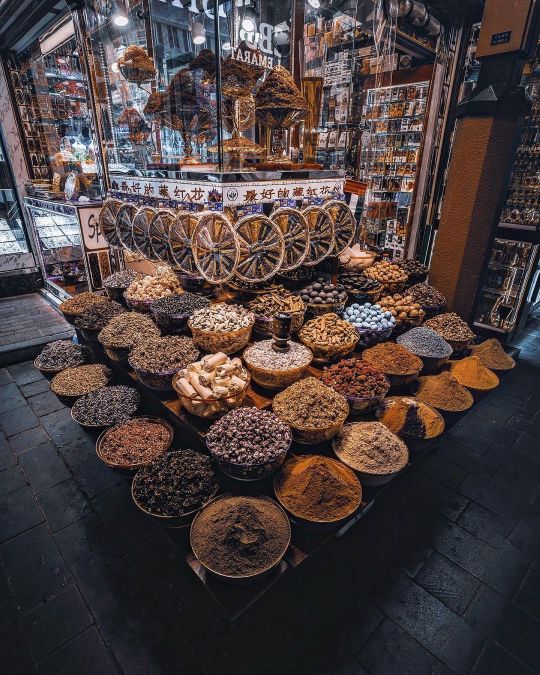
Cookery means…English thoroughness, French art, and Arabian hospitality; it means the knowledge of all fruits and herbs and balms and spices; it means carefulness, inventiveness, and watchfulness...It means, in fine, that you are to see imperatively that everyone has something nice to eat.
- John Ruskin
The history of spice is almost as old as human civilisation. It is a history of lands discovered, empires built and brought down, wars won and lost, treaties signed and flouted, flavours sought and offered, and the rise and fall of different religious practices and beliefs. Spices were among the most valuable items of trade in ancient and medieval times.
As long ago as 3500 BC the ancient Egyptians were using various spices for flavouring food, in cosmetics, and for embalming their dead. The use of spices spread through the Middle East to the eastern Mediterranean and Europe. Spices from China, Indonesia, India, and Ceylon (now Sri Lanka) were originally transported overland by donkey or camel caravans. For almost 5000 years, Arab middlemen controlled the spice trade, until European explorers discovered a sea route to India and other spice producing countries in the East.
A walk through the old souk or as its called the spice souk in Deira, a much older part of Dubai than the shinier futuristic side, is something I would recommend to anyone coming to Dubai. If you want history, you won’t see it in modern Dubai which is in a hurry to build the future. But come to the spice souk, and haggle and have some chai, and you can smell the history of the old Arab spice trade.
For a gourmand like myself who loves to cook with spices, this is a taste of heaven.
#ruskin#john ruskin#quote#spice#spice souk#souk#dubai#spice trade#history#cooking#cuisine#gourmand#deira#personal
94 notes
·
View notes
Text
“Harkha Bai, now Maryam-uz-Zamani and queen mother of the empire, is a prodigiously wealthy woman with her own ship, who controls her finances and trades under her own name. Indeed, many of the Mughal noblewomen, since the time of Akbar, have become independently wealthy as the Mughal empire has flourished. In addition to their monthly allowances, Mughal noblewomen are given expensive gifts by courtiers, own property, and further increase their wealth through trade. Of all the Mughal nobles who conduct trade, fully half of the names documented are that of women. Akbar had prodigiously increased the wealth of the Mughal empire and the Mughal noblewomen became consequently immeasurably wealthy. When Akbar dies, according to a Flemish visitor’s calculations, his gemstones alone, ‘his diamonds, rubies, emeralds, sapphires, pearls and other jewels’ will be valued at 60,520,521 rupees.
... Maryam-uz-Zamani’s favoured status at Jahangir’s court is reflected in the fact that she is one of only four members of the court (one of whom is Jahangir himself) and the only woman to have the high rank of 12,000 cavalry, and she is known to receive a jewel from every single nobleman at court ‘according to his estate’ every year on the occasion of the new year’s festival. But what Maryam-uz-Zamani is most interested in, what she invests her money in and actively participates in, is trade.
...It is from the hustling, garrulous town of Surat, where a scattershot of languages ricochets off the lanes while the merchants work, that Harkha Bai trades through the enormous ship that sails under her colours, the Rahimi. Harkha Bai, like the other Mughal noblewomen, cannot trade directly with the merchants and so the zenana employs a huge number of agents, middlemen and financial advisers, ‘mirroring in miniature the emperor’s own finance ministry’. The women send out their personal servants to bargain and negotiate with the Europeans at the court and gifts and favours are exchanged. The Rahimi is one of the largest vessels of any kind to sail the Indian seas. Her capacity is upwards of 1,500 tons and the ship has room for a load of 1,500 passengers. In 1613, the Rahimi is transporting goods worth 100,000 pounds equivalent to, in today’s currency, half a billion rupees. But the Rahimi, like Gulbadan’s Salimi and Ilahi thirty years previously, is also a Hajj ship. The Rahimi trades in Hindustan’s major exports—indigo, cotton and silks, but also leather, metal, carpets, spices, opium and jewels. In return, it brings back goods of particular interest to the noblewomen—gold, silver, ivory, pearls, amber, perfumes, wines, brocade, cutlery and glassware. But it also carries passengers to and from Mecca, for the sacred Hajj pilgrimage. Indeed the Rahimi is famous amongst the Europeans for being ‘the great pilgrimage ship’. Which is why the outrageous and scandalous piratical attacks by the Portuguese against the Rahimi in 1612 and 1613 will be considered so grave as to bring about a complete reversal of fortunes, both for the Portuguese and, incidentally, for the newly arrived English.
When the Rahimi is seized by the Portuguese in the autumn of 1613, just after the end of the monsoon season, and carried off to Goa, the tumult and outcry at the Mughal court is unprecedented. Everyone knows the Rahimi is Maryam-uz-Zamani’s ship, and she carries the requisite and loathed Portuguese pass, with its sacrilegious image of the Virgin Mary. The English are aghast at this action and describe the Rahimi as being ‘verye richly laden’, and even more provocatively, not only do the Portuguese seize the ship and its goods ‘but took also 700 persons of all sorts with them to Goa; which deeds of theirs is now grown so odious that it is like to bee the utter undoing of the Portungales in their parts’. So the Portuguese, in seizing the goods and passengers of a Hajj pilgrim ship filled with pilgrims, have carefully gauged the freight of their action and this is not only an act of piracy, but an act of religious persecution against the Mughal empire. It is clearly intended to be both a rebuke and a scathing warning to Jahangir, to dissuade any further contact and trade with the recently arrived English adventurers. But the Portuguese have miscalculated their hand. Jahangir is furious.
When it becomes clear to Jahangir and the court that the Portuguese are not going to return the Rahimi immediately, the emperor acts with crackling speed. Jahangir orders the halt of all traffic through Surat and this immediately paralyses the lucrative trade which has made the fortune of this city. He further shuts down the Jesuit church in Agra, which had been built under Akbar, and suspends all allowances to Portuguese priests living in Mughal India. Jahangir also sends his agent, Mukarrab Khan, to lay siege to the Portuguese town of Daman. These extreme actions taken by Jahangir are unusual, for the Mughal court has become used to the rapacious brutality of the Portuguese and has usually reacted by ignoring it or accommodating it if possible. But this is the Rahimi which has been seized by the Portuguese, Maryam-uz-Zamani’s flagship pilgrim ship, and the queen mother demands retribution. This is an altogether unusual situation, demonstrating the great cultural upheavals and the tectonic changes that are shaping the Mughal empire—this is a Hindu queen’s Muslim ship, carrying Hajj pilgrims in Christian waters patrolled by the Portuguese armada. This fraught situation lasts a long time, with neither side willing to concede defeat. But the age of Portuguese dominance in Indian waters has effectively been ended. ‘The Great Mogul’s mother was a great adventurer,’ writes an English agent succinctly, ‘which caused the Great Mogul to drive the Portingals out of the place.’
The capture of the Rahimi, and the insult it is perceived to be to the queen mother of the Mughal empire, precipitates the decline of Portuguese fortunes. Already in 1612, an EIC fleet under Captain Thomas Best had decisively defeated a Goa armada off Surat and had shown the Portuguese to be less than invincible. Jahangir even writes about the ‘good news’ of Portugal’s defeat at English hands with satisfaction in his Jahangirnama. ‘Battle had taken place’, he writes, between the English and the Portuguese, ‘most of whose ships were burned up by English fire’. This is the only incident involving the ‘firangis’ that Jahangir ever writes about in the Jahangirnama. Now, after the perfidious actions of the Portuguese, Jahangir is increasingly inclined to negotiate trade agreements with the English and in the next few years the English will slowly replace the Portuguese as the primary foreign power at the Mughal court. Harkha Bai lives another ten years, dying at the very respectable age of eighty-one in 1623. She never will get back the Rahimi, but this daughter of the desert, who has never seen the ocean, will have the satisfaction of knowing that she has been part of the process that evicts the great naval force of the Portuguese from Indian shores.”
- Ira Mukhoty, “Daughters of the Sun: Empresses, Queens and Begums of the Mughal Empire”
#history#historicwomendaily#indian history#india tag#mughal empire#mughal era#harkha bai#maryam-uz-zamani#mine#queue
26 notes
·
View notes
Text
In a nutshell:- the Committee of 300, headed by the Queen of England, (but not as the sovereign, because the City of London is not part of the UK) controls the world economy via the City of London Corporation.
• The City of London Corporation is made up of 108 Livery Companies, the Worshipful Company of Fuellers and the Worshipful Company of Mercers are two of the most prominent.
• The Bank of International Settlements (BIS) controls the worldwide banking system including the Federal Reserve System and the European Central Bank.
• The International Monetary Fund (IMF) and the World Bank work to indebt developing nations making them subservient to the developed nations of the world.
The Groups of 7, 20 and 30 act as financial regulators and middlemen servicing Central Banks and Investment Banks.
These regulators are unelected and empower the Financial Terrorists at the expense of the masses. Finally, the Investment Banks and financial services corporations gamble with their clients money with the reassurance that any losses will be paid by taxpayers.
Perfect scheme right?
https://t.me/LauraAbolichannel
6 notes
·
View notes
Photo

Portuguese Cochin
Cochin, located on the southwest coast of India, was a Portuguese colony from 1503 to 1663. Known to the Portuguese as Cochim, it was one of several important cities on India’s Malabar Coast and a great trade centre for spices like pepper. Cochin was the administrative capital of Portuguese India until it was replaced by Goa in 1530.
A fort was built at Cochin in 1503, the first in Portuguese India, as the Europeans used the city as their first headquarters in the East. The great explorer Vasco da Gama (c. 1469-1524) spent his last days in the city, and it remained a lucrative hub of the spice trade into the 17th century. The city was taken over by the Dutch in 1663, then the English in 1814, and finally gained independence with the rest of India in 1947. Today, the city is known as Kochi and is the most prosperous port in the Kerala region of India.
Vasco da Gama
In the 15th century, the Portuguese colonization of Madeira in the North Atlantic from 1420 was the first in a series of colonial stepping stones that eventually led to India. The treacherous Cape Bojador in West Africa was negotiated in 1434, the Azores were colonised from 1439, Cape Verde from 1462, and São Tomé and Principe from 1486. In 1488 Bartolomeu Dias sailed down the coast of West Africa and made the first voyage around the Cape of Good Hope, the southern tip of the African continent (now South Africa).
The famed Portuguese explorer Vasco da Gama followed in Dias’ wake and pioneered a maritime route from Portugal to India when in 1497-9, he sailed around the Cape of Good Hope, went up the coast of East Africa, and crossed the Indian Ocean to arrive at Calicut (now Kozhikode) on the south-west coast of India. His voyage, supported by King Manuel I of Portugal (r. 1495-1521), was intended to find a legendary Christian kingdom in the East and to give Portugal direct access to the Eastern spice trade and cut out the Arab middlemen traders. The first aim ended up being an illusion but the second was indeed achieved. For the first time, Europe could access by sea a trade which had been going on for centuries but which channelled luxury goods through the Red Sea and the Persian Gulf to be then taken by camel caravan to the Mediterranean. Such goods as pepper, ginger, cloves, and cinnamon were immensely popular in Europe and expensive.
Vasco da Gama, through a mix of inexperience, lack of trade goods, and Indian confidence in the status quo, failed to establish friendly trading relations with Calicut. A second Portuguese expedition, this time with 13 ships and 1500 men and commanded by Pedro Álvares Cabral, set off to repeat da Gama’s feat in March 1500 and was given the brief of muscling-in on Muslim trade by sinking any Arab ships they came across. Vasco da Gama sailed for a second time to India in 1502-3, this time with 15 ships. A result of this voyage was more trouble with the ruler of Calicut, but a trade treaty was agreed with Cochin further down the coast.
Continue reading...
17 notes
·
View notes
Text
Brussels Has More Power Than Rome Italy Balks At Climate Change Agenda
Italy’s new PM, Giorgia Meloni, is learning that she cannot pick and choose what policies Italy would like to adopt from the ruling authority in the European Union. I was willing to give Meloni the benefit of the doubt after she rose to power from virtually nowhere as a perceived anti-establishment, right-winged nationalist candidate who was neither a fascist nor neo-fascist, who rose to power from virtually nowhere. Unfortunately, she has been compromised by the Neocon agenda, perhaps a bit naïve as she is a newcomer. However, Meloni is a nationalist and has begun to realize that Brussels has more authority than Rome.
The EU is pushing full speed ahead to meet climate initiatives, and they would like to ban the sale of new fossil fuel cars by 2035. Meloni believes that emissions should be reduced, but said the near 10-year plan “makes no sense,” and believes the green agenda is “pursued even at the cost of sacrificing entire production and industrial sectors, such as the automotive industry.” She stated that these measures would not only cripple the industrial sector and automotive agency, but it would cause Europe to become dependent on foreign nations. Those same foreign nations will see a boost in their workforce as well as Europe will lose thousands of positions due to lost industries.
Europe became more dependent on foreign nations for energy in general after the ruling authority at the EU blindly adopted green initiatives. Meloni does not understand that supporting Ukraine against Russia is tied into the need for foreign energy dependence. Europe shot itself in the foot by losing Russian energy, not to mention the entire Nord Stream disaster. They can say they no longer need Russian exports but Europe is still purchasing Russian gas, albeit from middlemen like India at a marked-up price. The billions utterly wasted on Ukraine will never be reinvested into Europe.
The climate change agenda destroyed America’s energy independence. There are fewer sources for the West as a whole to rely on for energy now. Meloni called the climate change agenda “ideological madness,” but she must realize that the climate change agenda is tied into this push for the next world war. The EU does not want to default on its debt and this push for war is a way to ensure it is swept under the rug. Climate change initiatives, global conflicts, the coming push for digital currencies – all of this was laid out plain as day in the plans for the Great Reset. This is not the first time Meloni has dissented with the EU-World Economic Forum partnership as she rejected the woke agenda in an attempt to preserve Italy’s Catholic roots.
Climate change is not an isolated issue as it directly connects to plans to change the global economy and civilization as a whole. It was distressing to see Rome on my last visit as countless shops and restaurants I previously frequented have permanently shuttered since the pandemic lockdowns that were also a direct order of EU policies.
It is my hope that Meloni begins to step away from the Neocon agenda and focus on Italy’s economic issues. Socrates indicates that Italy is heading into a recession, and we saw the Italian share market crash one week after the Economic Model Confidence Model target of May 7. The fiscal mismanagement of Italy and the EU as a whole is simply unsustainable and the repercussions will be felt.
Source link
via
The Novum Times
0 notes
Text
What factors make Cyprus topmost surrogacy destination in Europe?
For many couples and people trying natural conception, surrogacy has turned into a ray of hope. That said, of the several locations throughout Europe, Cyprus is one of the best ones for surrogacy. Moreover, affordable IVF treatment prices, trustworthy surrogacy agencies, and established egg donation facilities are a few elements that help to explain this position. We shall go into great depth in this post on the reasons Cyprus is so popular for surrogacy.

Legal Framework and Encouraging Environment
Cyprus’s legal system is one of the main factors driving it to be a top surrogacy location. Moreover, cyprus has clear, supportive legislation about surrogacy unlike many other European nations. For intended parents, surrogates, and surrogacy agency in Cyprus, this legal clarity guarantees that everyone’s rights and obligations are clearly defined and safeguarded, therefore offering piece of mind.
The favorable surroundings go beyond only the legal ones. Further drawing Cyprus’s appeal for surrogacy is its cultural acceptability and well-developed healthcare system. Generally open and sympathetic to surrogacy, the local populace and medical professionals contribute to create a friendly environment for intended parents and surrogates equally.
Reasonably priced IVF treatment available in Cyprus
Many people seeking surrogacy give IVF (in vitro fertilization) treatment’s cost first priority. Moreover, IVF treatment is substantially less expensive in Cyprus than in other European nations as well as the United States. Quality is not sacrificed in order to achieve this and that’s where Cyprus stands apart. Cyprus’s clinics are well-known for its advanced facilities, high standards, and qualified medical staff as well as modern approach.
On the other side, given lower IVF treatment cost in Cyprus, intended parents follow their ambition of having a child free from the heavy financial challenges some countries could impose. Many clinics also provide complete packages comprising not only IVF but also other related treatments, therefore simplifying the procedure and reducing the stress for intended parents.
Superior Surrogacy Services
The surrogacy process depends much on surrogacy agency in Cyprus. Between planned parents, surrogates, and medical experts, they serve as middlemen offering support and coordination. There are some very respectable surrogacy agencies in Cyprus well-known for their expertise, openness, and thorough support systems.
Usually providing a range of services, a Cyprus surrogacy agency deals in:
Helping intending parents locate a qualified surrogate that satisfies their requirements and preferences helps them.
Offering direction and help with all legal facets of the surrogacy procedure.
Medical coordination is organizing and scheduling of medical appointments and treatments.
Counseling and support for both intended parents and surrogates should be provided all during the surrogacy process.
Crucially for the success of the surrogacy agreement, these agencies guarantee that the surrogacy process is legally compliant, emotionally helpful, and seamless.
Notable Egg Donation clinic Cyprus
For intended parents who cannot use their own eggs in particular, egg donation is typically a vital component of the surrogacy process. Moreover, several well-known egg donation clinics with strong success rates, moral policies, and strict donor screening procedures is quite evident in Cyprus.
Usually offering complete services, an egg donation facility in Cyprus consists in:
Complete medical, genetic, and psychological screening guarantees the health and fitness of egg donors
Safe and quick techniques for egg retrieval and storage abound
Latest methods of fertilizing eggs and implanting embryos to the surrogate’s uterus

Latest Medical Facilities and Experience
Cyprus provides state of the art medical facilities manned by highly qualified doctors with the latest technologies. Following international standards, the nation’s fertility clinics and hospitals guarantee that patients get first-rate treatment all through their surrogacy process.
The effectiveness of IVF and surrogacy treatments depends much on the knowledge of the medical staff—including embryologists, fertility experts, and support personnel. From first visits to post-procedural follow-ups, their experience and dedication guarantee that every element of the medical process is managed precisely and with care.
All-Inclusive Support Services
Surrogacy calls both emotional and logistical help in addition to medical treatments. That said, Cyprus is quite good in offering thorough support services covering all facets of the surrogacy process. These offerings consist of:
Professional counseling services enable intended parents and surrogates negotiate the emotional complexity of surrogacy.
Travel, lodging, and other logistical requirements for foreign intended parents can be helped with.
Support with regard to legal documentation, birth registration, and other post-natal needs.
The presence of these support services helps all the parties engaged in the surrogacy process to be more under control and less stressed.
Perfect Geographic Location and Accessibility
Cyprus’s ideal location and accessibility help to explain its appeal as a surrogate’s choice as well. This is where Intended parents from Europe, the Middle East, and beyond will find the nation conveniently reachable because to its international flight connectivity. The lovely settings and mild temperature help to increase the attractiveness even more by giving intended parents and surrogates comfortable and inviting surroundings.
Final words
Cyprus is one of the top European countries for surrogacy because of its supportive legal system, lower IVF treatment cost in Cyprus, excellent surrogacy agencies, well-known egg donation clinics, latest medical facilities, and thorough support services. These elements, together with the nation’s accessibility and friendly surroundings, make Cyprus a perfect place for intended parents trying to fulfill their desire of having a child by surrogacy.
Source: https://gaiafertility.wordpress.com/2024/06/19/what-factors-make-cyprus-topmost-surrogacy-destination-in-europe/
0 notes
Text
Tax records in Armenia highlight the government’s challenge in trying to disentangle the country’s economy from Russia. The single largest taxpaying entity in Armenia, records show, is an electronics retailer that appears to generate a large share of profits from exports to Russia.
Since Azerbaijani forces reconquered Nagorno-Karabakh, the Armenian government has moved to distance itself from Russia, which many Armenians believe failed to live up to security commitments to defend Armenia’s interests. Politically, Prime Minister Nikol Pashinyan has been quick to bolster relations with the European Union and United States. But making a political shift is proving a faster process than reorienting the Armenian economy, which has long been focused northward toward Russia.
Trade with sanctions-strapped Russia has proven highly lucrative for many Armenian businesses, which have reportedly adapted to acting as middlemen for Russian consumers cut off from direct access to Western goods. No entity seems to have benefited more than Mobile Center, an Armenian mobile phone and electronics retailer linked to local businessman Samvel Aleksanyan. The company’s revenue, allegedly boosted by exports to Russia, was such that it has surpassedArmenia’s largest mining company to become the largest taxpayer in Armenia, in terms of monetary contribution made to state coffers.
According to the Armenian government’s State Revenue Committee (SRC), the agency collected over $51 million (20 billion Armenian drams) from MobileCenter during the first quarter of 2024, three times higher than the taxes paid by the company during the same period the previous year. Prior to 2024, the company had not ranked among Armenia’s top taxpaying entities.
continue reading
0 notes
Text
5. Early 20th century colonization in Africa and continued mineral exploitation
African colonialism experienced a persistence and intensity in the early 20th century, especially with regard to European countries' exploitation of mineral resources. European corporations, such as "Union Minière du Haut Katanga" in the Democratic Republic of the Congo and "De Beers Consolidated Mines Ltd." in South Africa, were awarded profitable mining concessions by colonial authorities (Newbury, 1981, Radmann, 1978). European businesses benefited greatly economically from these concessions, which granted them exclusive rights to prospect, mine, and export minerals. They also gained control over the wealth generated by minerals.
African miners were subject to a highly institutionalized system of exploitation by Europeans, who determined not only the price of imported commodities but also the raw material prices. For instance, "“import trade, like her export trade, was monopolized by the expatriate firms" (America, 2024). Colonial powers invested in roads, ports, railroads, and telecommunications networks as a means of facilitating the mining and export of minerals. The movement of minerals from mining areas to coastal ports for export to Europe and other markets was made easier by initiatives like the Cape to Cairo Railway and ports in South Africa and Tanzania (Williams, 1921, Oritsejafor & Cooper, 2021).
However, forced labour and other unfair practices were closely linked to the mining industry in colonial Africa. African labourers had to put up with unfavourable working conditions, inadequate pay, and forced recruiting practices. European colonial businesses frequently used local middlemen—sometimes via pressure or deception—to recruit labourers. In addition, Africans were subjected to arbitrary detention, brutality, and coercion as a result of raiding, people trafficking, and forced labour laws enforced by colonial authorities. Taxation and indentured servitude policies served as further barriers to exploitative labour arrangements for African populations. These actions served as a stark reminder of the harsh realities of colonialism, which placed African lives and livelihoods at risk in the quest of mineral wealth. In this setting, systematic mineral resource exploitation, ongoing economic reliance, and ongoing social and economic inequality were characteristics of African colonization in the early 20th century.
America, R. F. (2024). Monopolization, Exploitation, Business Disruption, Loss of Profits, and Unjust Enrichment—Siphoning the Benefits from Trade—The Case of Nigeria. In Accounting for Colonialism. Springer International Publishing AG.
Newbury, C. (1981). Out of the pit: The capital accumulation of Cecil Rhodes. The Journal of Imperial and Commonwealth History, 10(1), 25-49. https://doi.org/10.1080/03086538108582605
Oritsejafor, E. O., & Cooper, A. D. (Eds.). (2021). Africa and the global system of capital accumulation. Routledge.
Radmann, W. (1978). The Nationalization of Zaire's Copper: From Union Minière to Gecamines. Africa Today, 25(4), 25-47. Retrieved from https://www.jstor.org/stable/4185805
Williams, R. (1921). The Cape to Cairo Railway. Journal of the Royal African Society, 20(80), 241–258.
0 notes